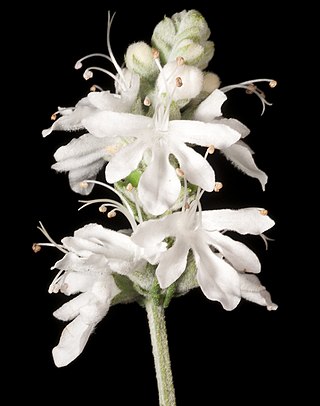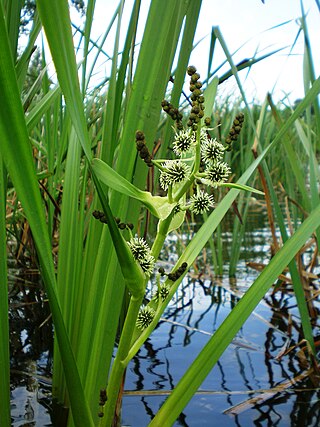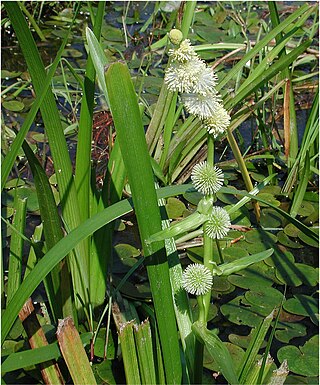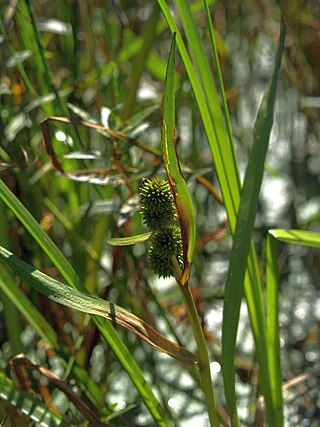
Hornbeams are hardwood trees in the plant genus Carpinus in the family Betulaceae. The 30–40 species occur across much of the temperate regions of the Northern Hemisphere.

Lamium (dead-nettles) is a genus of about 30 species of flowering plants in the family Lamiaceae, of which it is the type genus. They are all herbaceous plants native to Europe, Asia, and northern Africa, but several have become very successful weeds of crop fields and are now widely naturalised across much of the temperate world.

Cladium is a genus of large sedges, with a nearly worldwide distribution in tropical and temperate regions. These are plants characterized by long, narrow (grass-like) leaves having sharp, often serrated (sawtooth-like) margins, and flowering stems 1–3 m tall bearing a much-branched inflorescence. Like many plants found in wet habitats, it has deeply buried rhizomes that can produce tall shoots with dense canopies.

Cyperus is a large genus of about 700 species of sedges, distributed throughout all continents in both tropical and temperate regions.

Onopordum, or cottonthistle, is a genus of plants in the tribe Cardueae within the family Asteraceae. They are native to southern Europe, northern Africa, the Canary Islands, the Caucasus, and southwest and central Asia. They grow on disturbed land, roadsides, arable land and pastures.

Coriaria is the sole genus in the family Coriariaceae, which was described by Linnaeus in 1753. It includes 14 species of small trees, shrubs and subshrubs, with a widespread but disjunct distribution across warm temperate regions of the world, occurring as far apart as the Mediterranean region, southern and eastern Asia, New Zealand, the Pacific Ocean islands, and Central and South America.

Teucrium is a cosmopolitan genus of flowering plants in the family Lamiaceae, commonly known as germanders. Plants in this genus are perennial herbs or shrubs, with branches that are more or less square in cross-section, leaves arranged in opposite pairs, and flowers arranged in thyrses, the corolla with mostly white to cream-coloured, lobed petals.

Clethra is a genus of flowering shrubs or small trees described as a genus by Linnaeus in 1753.

Halesia, also known as silverbell or snowdrop tree, is a small genus of four or five species of deciduous large shrubs or small trees in the family Styracaceae.

Eriophorum is a genus of flowering plants in the family Cyperaceae, the sedge family. They are found throughout the arctic, subarctic, and temperate portions of the Northern Hemisphere in acid bog habitats, being particularly abundant in Arctic tundra regions.

Paris is a genus of flowering plants described by Linnaeus in 1753. It is widespread across Europe and Asia, with a center of diversity in China.

Cephalanthus is a genus of flowering plants in the family Rubiaceae. There are about six species that are commonly known as buttonbush.

Veratrum is a genus of flowering plants in the family Melanthiaceae. It occurs in damp habitats across much of temperate and subarctic Europe, Asia, and North America.

Meliosma is a genus of flowering plants in the family Sabiaceae, native to tropical to warm temperate regions of southern and eastern Asia and the Americas. It is traditionally considered to contain about 100 species; some botanists take a much more conservative view accepting only 20-25 species as distinct. They are trees or shrubs, growing to 10–45 m tall.

Epipremnum is a genus of flowering plants in the family Araceae, found in tropical forests from China, the Himalayas, and Southeast Asia to Australia the western Pacific. They are evergreen perennial vines climbing with the aid of aerial roots. They may be confused with other Monstereae such as Rhaphidophora, Scindapsus and Amydrium.

Sparganium erectum, the simplestem bur-reed or branched bur-reed, is a perennial plant species in the genus Sparganium.

Sparganium emersum is a species of flowering plant in the cat-tail family known by the common names European bur-reed and unbranched bur-reed. It has a circumboreal distribution, occurring throughout the northern latitudes of Eurasia and North America. It is an aquatic plant, growing in shallow water bodies such as ponds and streams. It can become abundant at times. It is a perennial herb producing a floating stem up to 2 meters long. The leaves may be limp and floating or stiff and erect, emerging above the water surface. The leaves are flat and straplike, sometimes with a triangular, keeled base that can help distinguish it from the similar Sparganium angustifolium. It is monoecious, individual plants bearing both male and female inflorescences. These are spherical, the male inflorescence a ball of stamens and the female inflorescence a ball of developing fruits growing beneath the male spheres.

Sparganium glomeratum, the clustered bur-reed, is a species of bur-reed. It is a water plant native to high elevation lakes and marshes of Europe, Asia, and North America. North American populations were doubted as introduced due to its scarce and scattered populations, but a recent herbarium survey found more localities of the species in the central of Canada, concluding the species as circumpolar species.

Saururus is a genus of plants in the family Saururaceae containing two species. Saururus cernuus is native to North America, and Saururus chinensis is native to Asia.
Sparganium acaule is a perennial plant found in the United States of America and Canada. This taxon was included within Sparganium emersum by Cook and Nicholls (1986) but was recently resurrected as a distinct species.




















